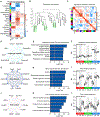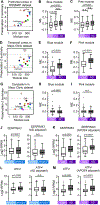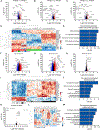Alzheimer's Risk Factors Age, APOE Genotype, and Sex Drive Distinct Molecular Pathways
- PMID: 32199103
- PMCID: PMC7388065
- DOI: 10.1016/j.neuron.2020.02.034
Alzheimer's Risk Factors Age, APOE Genotype, and Sex Drive Distinct Molecular Pathways
Abstract
Evidence suggests interplay among the three major risk factors for Alzheimer's disease (AD): age, APOE genotype, and sex. Here, we present comprehensive datasets and analyses of brain transcriptomes and blood metabolomes from human apoE2-, apoE3-, and apoE4-targeted replacement mice across young, middle, and old ages with both sexes. We found that age had the greatest impact on brain transcriptomes highlighted by an immune module led by Trem2 and Tyrobp, whereas APOE4 was associated with upregulation of multiple Serpina3 genes. Importantly, these networks and gene expression changes were mostly conserved in human brains. Finally, we observed a significant interaction between age, APOE genotype, and sex on unfolded protein response pathway. In the periphery, APOE2 drove distinct blood metabolome profile highlighted by the upregulation of lipid metabolites. Our work identifies unique and interactive molecular pathways underlying AD risk factors providing valuable resources for discovery and validation research in model systems and humans.
Keywords: APOE; Alzheimer’s disease; Serpina3; age; extracellular vesicles; inflammation; lipid metabolism; metabolomics; sex; transcriptomics.
Copyright © 2020 Elsevier Inc. All rights reserved.
Conflict of interest statement
Declaration of Interests M.A. is co-inventor on patent WO2018049268 in this field. The other authors declare no competing interests.
Figures







Similar articles
-
Differential Signaling Mediated by ApoE2, ApoE3, and ApoE4 in Human Neurons Parallels Alzheimer's Disease Risk.J Neurosci. 2019 Sep 11;39(37):7408-7427. doi: 10.1523/JNEUROSCI.2994-18.2019. Epub 2019 Jul 22. J Neurosci. 2019. PMID: 31331998 Free PMC article.
-
Effect of Chronic Cadmium Exposure on Brain and Liver Transporters and Drug-Metabolizing Enzymes in Male and Female Mice Genetically Predisposed to Alzheimer's Disease.Drug Metab Dispos. 2022 Oct;50(10):1414-1428. doi: 10.1124/dmd.121.000453. Epub 2022 Jul 25. Drug Metab Dispos. 2022. PMID: 35878927 Free PMC article.
-
Humanized APOE genotypes influence lifespan independently of tau aggregation in the P301S mouse model of tauopathy.Acta Neuropathol Commun. 2023 Jun 19;11(1):99. doi: 10.1186/s40478-023-01581-2. Acta Neuropathol Commun. 2023. PMID: 37337279 Free PMC article.
-
Apolipoprotein E and oxidative stress in brain with relevance to Alzheimer's disease.Neurobiol Dis. 2020 May;138:104795. doi: 10.1016/j.nbd.2020.104795. Epub 2020 Feb 6. Neurobiol Dis. 2020. PMID: 32036033 Free PMC article. Review.
-
APOE in the bullseye of neurodegenerative diseases: impact of the APOE genotype in Alzheimer's disease pathology and brain diseases.Mol Neurodegener. 2022 Sep 24;17(1):62. doi: 10.1186/s13024-022-00566-4. Mol Neurodegener. 2022. PMID: 36153580 Free PMC article. Review.
Cited by
-
Metabolomic and lipidomic signatures in autosomal dominant and late-onset Alzheimer's disease brains.Alzheimers Dement. 2023 May;19(5):1785-1799. doi: 10.1002/alz.12800. Epub 2022 Oct 17. Alzheimers Dement. 2023. PMID: 36251323 Free PMC article.
-
A Function of Amyloid-β in Mediating Activity-Dependent Axon/Synapse Competition May Unify Its Roles in Brain Physiology and Pathology.J Alzheimers Dis. 2023;92(1):29-57. doi: 10.3233/JAD-221042. J Alzheimers Dis. 2023. PMID: 36710681 Free PMC article. Review.
-
Obesity affects brain cortex gene expression in an APOE genotype and sex dependent manner.Int J Obes (Lond). 2024 Jun;48(6):841-848. doi: 10.1038/s41366-024-01481-y. Epub 2024 Mar 7. Int J Obes (Lond). 2024. PMID: 38454009 Free PMC article.
-
Default mode network connectivity and cognition in the aging brain: the effects of age, sex, and APOE genotype.Neurobiol Aging. 2021 Aug;104:10-23. doi: 10.1016/j.neurobiolaging.2021.03.013. Epub 2021 Apr 2. Neurobiol Aging. 2021. PMID: 33957555 Free PMC article.
-
Alzheimer's pathogenic mechanisms and underlying sex difference.Cell Mol Life Sci. 2021 Jun;78(11):4907-4920. doi: 10.1007/s00018-021-03830-w. Epub 2021 Apr 12. Cell Mol Life Sci. 2021. PMID: 33844047 Free PMC article. Review.
References
-
- Abraham CR, McGraw WT, Slot F, and Yamin R (2000). Alpha 1-antichymotrypsin inhibits A beta degradation in vitro and in vivo. Ann N Y Acad Sci 920, 245–248. - PubMed
-
- Abraham CR, Selkoe DJ, and Potter H (1988). Immunochemical identification of the serine protease inhibitor alpha 1-antichymotrypsin in the brain amyloid deposits of Alzheimer’s disease. Cell 52, 487–501. - PubMed
-
- Abraham CR, Shirahama T, and Potter H (1990). Alpha 1-antichymotrypsin is associated solely with amyloid deposits containing the beta-protein. Amyloid and cell localization of alpha 1-antichymotrypsin. Neurobiol Aging 11, 123–129. - PubMed
Publication types
MeSH terms
Substances
Grants and funding
- P50 AG016574/AG/NIA NIH HHS/United States
- P01 NS074969/NS/NINDS NIH HHS/United States
- R01 AG017917/AG/NIA NIH HHS/United States
- RF1 AG051504/AG/NIA NIH HHS/United States
- RF1 AG062110/AG/NIA NIH HHS/United States
- R01 NS080820/NS/NINDS NIH HHS/United States
- U01 AG046139/AG/NIA NIH HHS/United States
- RF1 AG046205/AG/NIA NIH HHS/United States
- U01 AG061359/AG/NIA NIH HHS/United States
- P01 AG017216/AG/NIA NIH HHS/United States
- R01 AG046171/AG/NIA NIH HHS/United States
- R01 AG035355/AG/NIA NIH HHS/United States
- R01 AG027924/AG/NIA NIH HHS/United States
- P30 AG010161/AG/NIA NIH HHS/United States
- R01 CA200572/CA/NCI NIH HHS/United States
- R01 AG061796/AG/NIA NIH HHS/United States
- R01 AG032990/AG/NIA NIH HHS/United States
- F31 AG051356/AG/NIA NIH HHS/United States
- R37 AG027924/AG/NIA NIH HHS/United States
- P01 AG003949/AG/NIA NIH HHS/United States
- U24 NS072026/NS/NINDS NIH HHS/United States
- P30 AG019610/AG/NIA NIH HHS/United States
- R01 AG066395/AG/NIA NIH HHS/United States
- P50 AG025711/AG/NIA NIH HHS/United States
- RF1 AG057181/AG/NIA NIH HHS/United States
- R21 AG052423/AG/NIA NIH HHS/United States
- RF1 AG056130/AG/NIA NIH HHS/United States
- RF1 AG051550/AG/NIA NIH HHS/United States
- R01 AG018023/AG/NIA NIH HHS/United States
- U01 AG006786/AG/NIA NIH HHS/United States
- R01 AG015819/AG/NIA NIH HHS/United States
LinkOut - more resources
Full Text Sources
Medical
Molecular Biology Databases
Miscellaneous

